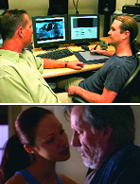
Director Robert Rodriguez took his Spy Kids 3D, featuring the many faces of Sly Stallone, to Post Logic's Cinema Digital Theater. The movie was shot on 24p HD.
|
The digital intermediate is a process that allows directors and cinematographers to extend total creative control over the look of their movie beyond the camera into post production. Working at near film resolution, the digital intermediate process enables filmmakers to manipulate the color, mood, lighting and virtually any other attribute of their imagery with unprecedented precision to tell a better story.
Regardless of whether the movie has been shot on 35mm film, 24p HD or even the PAL DV format - or fabricated within the CGI environment - the digital intermediate can benefit the project creatively from film scanning, color correction, editorial, audio mixing, visual effects, even defect fixes, through to the final recording onto 35mm film.
While the intent of the digital intermediate is to prepare a feature film for theatrical release, it can serve as a universal master from which to create all video deliverables - for the DVD, airline, international television, HDTV and home video markets - in a very efficient and cost-effective manner. This is because, once the colorist has established the aesthetic look for the theatrical film, he or she can ensure that the same look translates accurately to all the video versions as well.

Cinesite's Dan Lombardo says the studio is seeing "exponential growth" in the DI business. A recent Cinesite project was the feature film S.W.A.T.
|
CINESITE WELCOMES THE REVOLUTION
"We're seeing exponential growth in the digital intermediate business," says Dan Lombardo, president/GM for Cinesite (www.cinesite.com) in Hollywood. "Last year, there were 25 films done using digital intermediates, this year there are going to be 50. He believes that "next year, we'll see 100 films and the year after that 200 films. And, within five years, 60 percent of all motion pictures will be done using the digital intermediate process."
Calling the digital intermediate trend "a revolution," Lombardo adds that Cinesite, a wholly-owned subsidiary of Eastman Kodak Company, restructured in June 2003 by consolidating its digital intermediate, digital film mastering and film restoration services in Hollywood and moving all of its 3D visual effects business to its London facility.
"Today, the digital intermediate process costs eight to 10 times more than traditional color timing in the lab. But demand for digital intermediates will grow as prices come down and equipment gets faster and more cost efficient to operate," says Lombardo.

Post Logic's DI pipeline features the da Vinci 2K, Pandora Pixi and Quantel iQ.
|
But considering that movies like Pleasantville and O Brother Where Art Thou could not have achieved their classic looks without leveraging sophisticated, realtime digital color correction (provided by Cinesite/Hollywood), the benefits still outweigh the costs. Jerry Pooler, Cinesite's executive creative director, says, "Color correction was integral to the storylines of Pleasantville and O Brother Where Art Thou. Only in the digital world can you isolate a certain area within a frame and manipulate the colors, lighting and mood within that isolated area, without affecting the rest of the frame."
For Hart's War, a feature finished at Cinesite/Hollywood, an interrogation scene was darkened and the colors "dialed back" to give it a cool, menacing feel that could not be captured in production. In the movie Traffic, Cinesite/Hollywood applied color correction to a 40-minute segment, shot on location in Tijuana, Mexico, to give it a hot, dusty, sepia-toned look that helped set the mood of the scene. Also, for movies where the storyline calls for settings in the decades of the 1950s or 1960s, Pooler says color correction can mimic the film stocks of those time periods so the illusion rings true with viewers.
Currently, Open Range (with Kevin Costner) and S.W.A.T. (with Colin Farrell) are in Cinesite's digital intermediate pipeline, which includes several Kodak Cineon Lightning scanners and Lightning II laser film recorders. A Northlight film scanner, manufactured by FilmLight in London, using a Kodak light array capture component, has recently been added for film scanning of up to 6K resolution.

The feature Frida underwent the digital intermediate process at Efilm. They own a number of Arrilaser film recorders.
|
POST LOGIC'S DIGITAL THEATER
For Post Logic Studios, the digital intermediate process is a natural extension of its high-quality digital mastering of motion pictures for television, after-market video and DVD. Now, in its new Post Logic Cinema Digital Theater, film directors and cinematographers can apply digital color correction and other electronic processes to a universal file for unprecedented creative and technical control over the theatrical product.
"The digital intermediate does not happen in a vacuum, nor does it reside in the film laboratory," says Barry Snyder, president/CEO of Post Logic Studios (www.postlogic.com) in Hollywood.
"It is primarily a digital process, born through the advent and application of innovations in video and now applied to film, that intertwines the artist's vision more intimately with the final delivery form. It is also integrally connected to other post production functions, including editing, visual effects, video versioning, audio and quality control."

Technique takes on Pirates of the Caribbean
|
With its 24-by-10-foot screen and (AC-3) stereo surround sound, Post Logic's (MPAA-compliant) Cinema Digital Theater provides an ideal setting for comparing and evaluating every aspect of a motion picture as it moves through the digital intermediate process. This is because the plush, 20-seat space offers one-touch remote control of projectors, room settings and virtually every component in Post Logic's full-service digital intermediate pipeline.
This infrastructure includes a Kinoton FP30 E-Q film projection system, a DLP Cinema projector, Thomson Spirit and Cintel C-Reality telecines, as well as the da Vinci 2K, Pandora Pixi and Quantel iQ systems, capable of realtime color correction of 2K or better resolution imagery. The facility's expert staff, which includes HD colorists Lou Levinson, Bryan McMahan, John Persichetti, and Michael Underwood, have all worked closely with Hollywood's A-list of directors, such as Steven Spielberg, Sam Mendes and Frances Ford Coppola, and DPs like Vittorio Storaro and Janusz Kaminski.

Sunset Digital "sucked all the color out" of this indie film The Wanted. This now B&W film was shot on Panasonic VariCam and filmed onto 35mm for presentation.
|
Director Robert Rodriguez, another loyal client, exclusively finished his latest movie Spy Kids 3D using Post Logic's digital intermediate process. In this sequel, viewers get 3D glasses so they can appreciate the over 60-minutes worth of 3D effects. "Like the two previous Spy Kids movies, Spy Kids 3D was shot entirely on 24p HD. Because there has to be a film negative for theatrical distribution, you simply couldn't do a movie like this without the digital intermediate process," says Larry Birstock, executive VP of Post Logic Studios. "The extensive visual effects also made it an ideal candidate to benefit from the digital intermediate process."
As with any new technology, technical challenges often arise that have no off-the-shelf solution. To succeed in today's digital intermediate business, true pioneers have to develop their own breakthrough solutions. One such challenge is the conversion of colors between the film and video worlds.
"Many digital intermediate service providers claim that they can refer to Look-Up Tables and have the computer spit out the correct formula to convert one color space to another. We have not found that to be the case," says Snyder. "We feel the data still needs to be massaged, and we always have our experienced colorists judge if the desired results have been achieved. In fact, before we deliver any version, our colorists evaluate it on its ultimate distribution format to make sure it conforms to the technical and aesthetic standards our clients expect."

(Top: L-R): IO Film executive producer Chip Potter and CTO Kevin Mullican. For DI work on This Girl's Life, the studio employed custom hardware and software.
|
SUNSET SERVICES THE INDIE AND MORE
"At Sunset Digital, we look at independent filmmakers as real people working on real budgets," says Ron Burdett, CEO/chairman/founder of Sunset Digital (www.sunsetdigital.net) in Glendale, CA. "And we feel that the digital intermediate process is very enabling to them. Using new electronic acquisition tools, like the Panasonic VariCam 720p HD and Sony HDCAM for 24p HD, independent filmmakers can get their movies made more affordably than would be possible with film."
But once their movies "get picked up" at film festivals, like Sundance, he says, they then need to have a 35mm film negative for theatrical distribution. "The digital intermediate process helps them create that film, and the quality of the HD imagery really holds up."
Of six independent films that recently went through the digital intermediate process at Sunset Digital, three were picked up for distribution at Sundance. Of the three, The Love Object was shot on film, while Dopamine was shot on 720p HD and Prey for Rock and Roll was shot on HDCAM.
At an "open house" held at Sunset Digital in June, 200 independent filmmakers showed up to learn about how Sunset's digital intermediate services could help them realize their creative projects. "We made it clear to everyone that it's not about film versus digital," explains Burdett. "HD acquisition and the digital intermediate process are promoting a phenomenal new art form that enables filmmakers to use their creative juices to tell a story using electronic images that could be made to look as good as film."
In many cases, the imagery could not have been produced using traditional filmmaking processes. At the open house, attendees were shown a B&W short film called The Wanted, by independent filmmaker Matt Williams. According to Sunset Digital's COO, Jeff Ross, "People really took a step back when we explained that Matt had shot it in color [using the Panasonic VariCam 720p HD camcorder] and then we 'sucked all the color out' in the digital intermediate process. When it was finished, it was a gorgeous B&W movie that really maximized the dynamic range of the imagery." At the end of the process, the B&W images were recorded onto 35mm color film.
Besides the budget-conscious independent film community, Burdett reports that the economic recession has had an enormous impact on Hollywood budgets and margins, and that many major motion pictures are also benefiting from the cost efficiency of the digital intermediate process.
IO FILM CUSTOMIZES DI PROCESS
"A digital intermediate is a process where all of the creative decisions are made using a digital representation of your original imagery at the resolution that will be your final resolution, not a downconverted or proxy version of it," explains Kevin Mullican, CTO at IO Film (www.iofilm.net) in North Hollywood. "But the key for us is that using our custom hardware and software solutions, we're able to produce digital intermediates at HD resolution with high-quality results.
"But, if you don't have customized solutions to support the digital intermediate process, then you're going to be dead in the water," he continues. "You can't buy off-the-shelf software for every problem because the integration of all the components in the pipeline hasn't all been figured out. At IO Film, we've developed our own custom solutions to bridge the gaps and ensure quality control. If you're only buying off-the-shelf solutions, the only thing you'll be competing on is price, and that's always a losing proposition."
IO Film's custom hardware and software was used extensively on the finishing of This Girl's Life, an independent feature film starring James Woods. The film, which was shot in the Panasonic VariCam 720p HD format, was filmed onto 35mm film and presented at the CineVegas International Film Festival in June.
With This Girl's Life, Mullican says, "Problems that occurred in production showed up in post production, such as low light digital noise, saturation and contrast issues, and more. By writing software (in C++) and applying real color science technology, we were able to fix those problems and ensure our clients the look they wanted. It's not just about the equipment you use, it's about managing the data so that all the color spaces are converted properly without deterioration."
|
|
|
|
|
|
|
|
|
|
|
|
|
|
|
|
|

IO Film just added a Panasonic DVCPRO HD 1700 VTR, which now incorporates conversion hardware needed to convert the Panasonic VariCam's variable frame rates, from slow to fast motion, as well as 720p to 1080p HD. This VTR directly feeds IO Film's Avid DS|HD, which can work in 720p, 1080i or 1080p HD formats.
EFILM OFFERS PROPRIETARY TOOLS
Efilm uses a variety of devices, such as Arrilaser film recorders, as part of its digital intermediate service. But Efilm also develops its own proprietary image processing software.
"Since we began seven years ago, we've always had to engineer our own custom solutions - writing our own software and developing techniques wherever they did not exist - to enable us to work at this high level," says Michael Cooper, VP in charge of business development, for Efilm (www.efilm. com) in Hollywood.
With 25 people dedicated to R&D, Efilm regularly employs its own custom software to either optimize the facility's throughput or to solve challenging creative problems for its clients' movie projects. Efilm's custom software also ensures quality control in critical decision-making areas, like its digital timing room.
"We offer the ability to screen digital intermediates using our own optically-modified digital projectors that can simulate the output of many display devices and different types of film stock. And we can operate these display devices interactively and in realtime to adjust the colors and other image attributes so clients can really see how their movies will look in the theaters," says Bill Feightner, Efilm's president of technology.
"We also shoot film and send it for processing at area labs daily to make sure that we're tracking with them," says Coopers. "Based on the results of this test and our video and film expertise, we compensate for photochemical variations when we record locked images to film to ensure a stable, accurate film display. Our clients understand that the digital intermediate is more quality controlled and consistent than a film process in giving them the look they want. And once directors and DPs know what our digital intermediate process can do for them, very often they plan to use those capabilities before the cameras start to roll on their next productions."
Among the movies for which Efilm provided digital intermediate service are Frida, Charlie's Angels 2, Terminator 3 and American Wedding, the sequel to American Pie, coming to theaters this month.
CO3 hosts bad boys ii
At Company 3, Bad Boys II was finished using the digital intermediate process and images scanned to 2K data files by a Thomson Spirit DataCine telecine/scanner. The summer action movie, produced by Jerry Bruckheimer, was brought into Company 3's Quantel iQ finishing system for conforming, compositing, visual effects, color correction and other creative manipulation that was required.
"There were 5,000 cuts in this two-hour movie, and a lot of car chases and action sequences, all of which were shot throughout Miami over several months," explains Stefan Sonnenfeld, president of Company 3 (www.company3.com) in Santa Monica. "As a result, some scenes were shot over many days, with the light changing all over the place. So we needed to get a consistent look over the quality of the lighting and alter the scenes to better fit director Michael Bay's strong, stylized vision,"
While Sonnenfeld believes that the digital intermediate process is the wave of the future, he points out, "To get a good product, it must be done in cooperation with the film labs, like Technicolor and Deluxe, because you're always having to run film prints. So digital intermediates will not replace the film labs, and the traditional method of color timing in the labs will continue to work well for some films. But for movies with hundreds of effects shots or complex action scenes, the digital intermediate helps you achieve a more cohesive look."
Also, Sonnenfeld says that the digital intermediate process can be very cost effective because many different formats and deliverables can be created efficiently and consistently from a single film transfer, which can benefit and support the marketing objectives of the movie studios.
STAYING THE 2K COURSE
Lastly, while the experts we spoke with said there are virtually no creative limitations to the digital intermediate process, they all agreed that the greatest technical challenge is storing all the movie data online so it's readily accessible for creative decision-making.
Ron Burdett of Sunset Digital estimates that, "At 2K resolution, a two-hour movie requires 5TB of storage, whereas at 4K resolution, storage demands increase four-fold to 20TB, including the selects, the out-takes and other imagery needed for reference. If you've got six movies in the works at once, that can require over 30TB of storage, which is very costly," Burdett says. "The math is staggering, which is why the digital intermediate process will likely remain at 2K resolution for the foreseeable future." | |